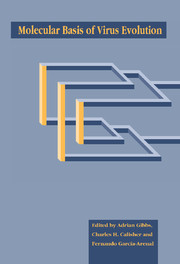Book contents
- Frontmatter
- Contents
- List of contributors
- Editors' preface
- Conference participants
- 1 Introduction and guide
- Part I The impact of viral diseases
- Part II Origins of viruses and their genes
- Part III Sources of virus variation
- Part IV Molecular interactions of viruses and their hosts
- Part V Viruses, hosts and populations
- Part VI Case studies of viral taxa; their systematics and evolution
- 18 Evolution of poxviruses and African swine fever virus
- 19 Molecular systematics of the flaviviruses and their relatives
- 20 Herpesviridae
- 21 Aphthovirus evolution
- 22 Evolution of the Bunyaviridae
- 23 Evolution of the tobamoviruses
- 24 The luteovirus supergroup: rampant recombination and persistent partnerships
- 25 The evolution of the Reoviridae
- 26 Genetic variation and evolution of satellite viruses and satellite RNAs
- 27 Molecular evolution of the retroid family
- 28 Adaptation of members of the Orthomyxoviridae family to transmission by ticks Patricia
- 29 The Order Mononegavirales: evolutionary relationships and mechanisms of variation
- 30 The molecular evolution of the human immunodeficiency viruses
- 31 Molecular evolution of papillomaviruses
- 32 Molecular systematics of the Potyviridae, the largest plant virus family
- 33 Evolution of alphaviruses
- 34 Evolution of influenza viruses: rapid evolution and stasis
- Part VII Techniques for viral systematics
- Index
18 - Evolution of poxviruses and African swine fever virus
Published online by Cambridge University Press: 04 May 2010
- Frontmatter
- Contents
- List of contributors
- Editors' preface
- Conference participants
- 1 Introduction and guide
- Part I The impact of viral diseases
- Part II Origins of viruses and their genes
- Part III Sources of virus variation
- Part IV Molecular interactions of viruses and their hosts
- Part V Viruses, hosts and populations
- Part VI Case studies of viral taxa; their systematics and evolution
- 18 Evolution of poxviruses and African swine fever virus
- 19 Molecular systematics of the flaviviruses and their relatives
- 20 Herpesviridae
- 21 Aphthovirus evolution
- 22 Evolution of the Bunyaviridae
- 23 Evolution of the tobamoviruses
- 24 The luteovirus supergroup: rampant recombination and persistent partnerships
- 25 The evolution of the Reoviridae
- 26 Genetic variation and evolution of satellite viruses and satellite RNAs
- 27 Molecular evolution of the retroid family
- 28 Adaptation of members of the Orthomyxoviridae family to transmission by ticks Patricia
- 29 The Order Mononegavirales: evolutionary relationships and mechanisms of variation
- 30 The molecular evolution of the human immunodeficiency viruses
- 31 Molecular evolution of papillomaviruses
- 32 Molecular systematics of the Potyviridae, the largest plant virus family
- 33 Evolution of alphaviruses
- 34 Evolution of influenza viruses: rapid evolution and stasis
- Part VII Techniques for viral systematics
- Index
Summary
Introduction
Poxviruses are a family of viruses with large DNA genomes that include pathogens of vertebrates (subfamily Chordopoxvirinae) and of invertebrates (subfamily Entomopoxvirinae) (Table 18.1). The prototype poxvirus is vaccinia virus, a member of the genus Orthopoxvirus (Dales & Pogo, 1981; Buller & Palumbo, 1991; Moss, 1990, 1991). Vaccinia virus was successfully used for almost 200 years for smallpox vaccination. The origin and passage history of vaccinia virus are obscure; however, analysis of vaccine strains indicate that the virus is most closely related to, but is distinct from, variola virus, which causes smallpox, and also cowpox and monkeypox viruses.
Poxvirus virions are large (300-400 nm) oval particles that contain at least two lipoprotein envelopes. The virion is composed of a DNA molecule and various amounts of more than 100 protein species, a number of which possess enzymatic activity. The poxviruses replicate in the cytoplasm of the cell, where their enzymes involved in nucleotide metabolism, DNA replication and transcription are expressed. The coding of these enzymes makes the virus independent of the corresponding host cell enzymes and, consequently, the virus is able to carry out gene expression and DNA replication in enucleated cells. African swine fever virus (ASFV) occupies an anomalous taxonomic position and has not been assigned to any major virus family (Vinuela, 1985, 1987; Wilkinson, 1989). Although it was originally classified as a member of the family Iridoviridae, its unique characteristics justified its separation from this group. ASFV naturally infects warthogs and bush pigs in southern and eastern Africa. It also infects the domestic pig, causing severe economic losses in the affected countries.
- Type
- Chapter
- Information
- Molecular Basis of Virus Evolution , pp. 255 - 269Publisher: Cambridge University PressPrint publication year: 1995
- 3
- Cited by



